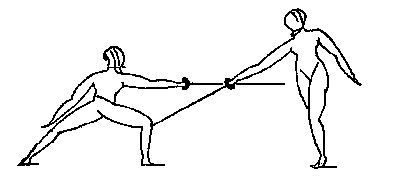

Nevertheless, the basic epee technique is very similar to that of foil, only modified by the tactical considerations dictated by the longer fencing measure, the unrestricted target and the absence of conventions, i.e. right of way.
Originally, the idea was to reproduce as closely as possible the conditions of an actual duel and consequently the first fencer to receive a hit was adjudged the loser. Subsequently, the number of hits was increased, first to the best of five in 1932, finally to the best of nine in 1955, similarly to the other weapons and accordingly somewhat reducing the realism. In pursuance of verisimilitude, moreover, the majority of epee competitions took place in the open air; not until 1937 was the British Championship held indoors at Salle Bertrand.
The epee was the first weapon to be electrified, with a spring-head in place of the point d'arret (triple barged flat head) previously used to cover the sharp point left exposed when duelling.
The rules for epee, like those of foil and sabre, were more or less definitively framed in Paris in 1914, by codifying the several existing sets of laws.
-taken from the A - Z of Fencing by E.D. Morton

Valid target is in white.